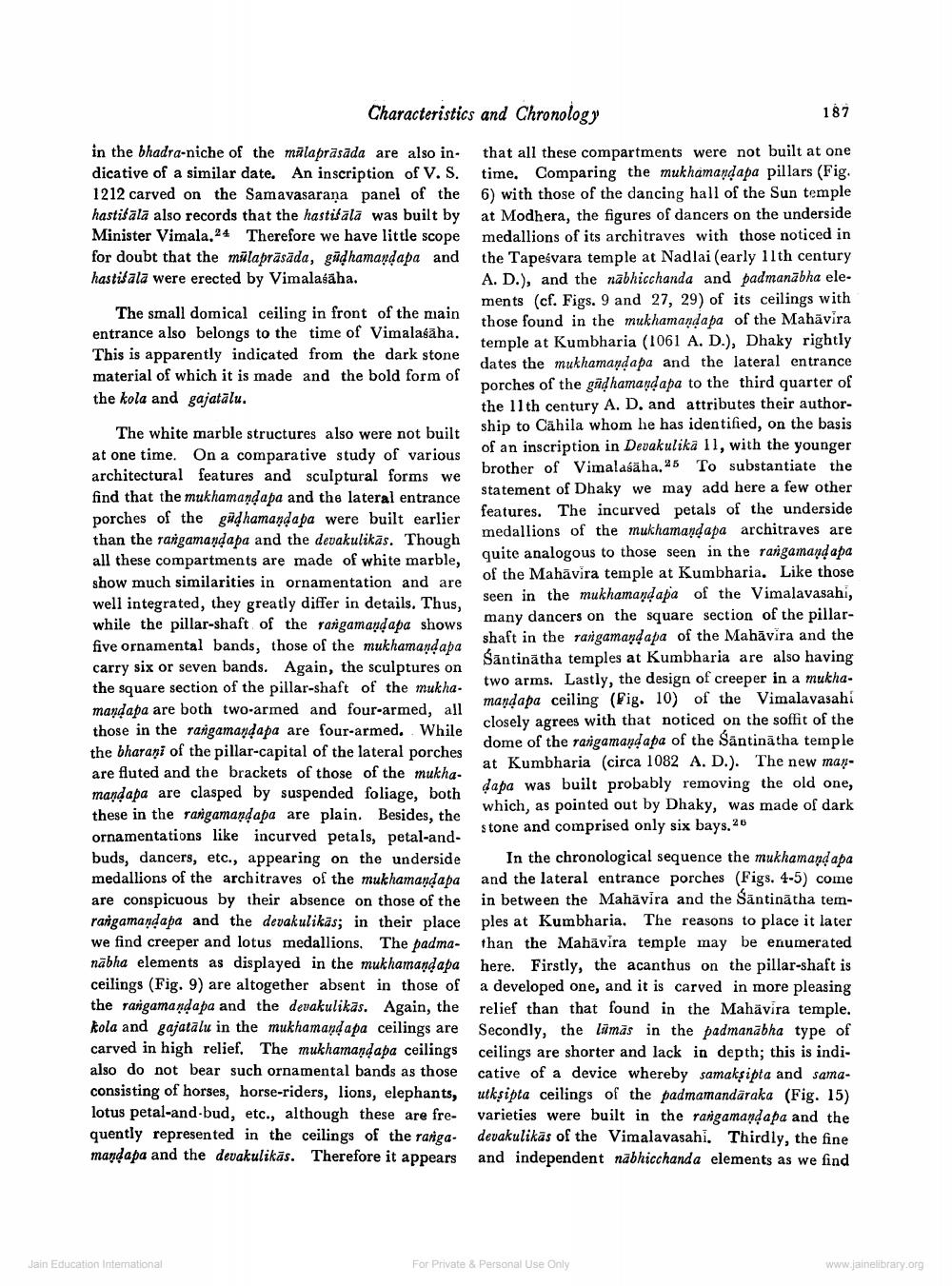________________
Characteristics and Chronology
187
in the bhadra-niche of the mālaprāsada are also in dicative of a similar date. An inscription of V. S. 1212 carved on the Samavasarana panel of the hastišala also records that the hastišala was built by Minister Vimala, 24 Therefore we have little scope for doubt that the malaprāsāda, gūdhamandapa and hastišala were erected by Vimalasäha.
The small domical ceiling in front of the main entrance also belongs to the time of Vimalasaha. This is apparently indicated from the dark stone material of which it is made and the bold form of the kola and gajatālu.
The white marble structures also were not built at one time. On a comparative study of various architectural features and sculptural forms we find that the mukhamandapa and the lateral entrance porches of the gūdhamandapa were built earlier than the rangamandapa and the devakulikās. Though all these compartments are made of white marble, show much similarities in ornamentation and are well integrated, they greatly differ in details. Thus, while the pillar-shaft of the rangamandapa shows five ornamental bands, those of the mukhamandapa carry six or seven bands. Again, the sculptures on the square section of the pillar-shaft of the mukha. mandapa are both two-armed and four-armed, all those in the rangamandapa are four-armed. While the bharani of the pillar-capital of the lateral porches are fluted and the brackets of those of the mukha. mandapa are clasped by suspended foliage, both these in the rangamandapa are plain. Besides, the ornamentations like incurved petals, petal-andbuds, dancers, etc., appearing on the underside medallions of the architraves of the mukhamandapa are conspicuous by their absence on those of the rangamandapa and the devakulikas; in their place we find creeper and lotus medallions. The padma- nabha elements as displayed in the mukhamandapa ceilings (Fig. 9) are altogether absent in those of the rangamandapa and the devakulikās. Again, the kola and gajatalu in the mukhamandapa ceilings are carved in high relief. The mukhamandapa ceilings also do not bear such ornamental bands as those consisting of horses, horse-riders, lions, elephants, lotus petal-and-bud, etc., although these are fre- quently represented in the ceilings of the ranga. mandapa and the devakulikās. Therefore it appears
that all these compartments were not built at one time. Comparing the mukhamandapa pillars (Fig. 6) with those of the dancing hall of the Sun temple at Modhera, the figures of dancers on the underside medallions of its architraves with those noticed in the Tapeśvara temple at Nadlai (early 11th century A. D.), and the nābhicchanda and padmanabha elements (cf. Figs. 9 and 27, 29) of its ceilings with those found in the mukhamandapa of the Mahävira temple at Kumbharia (1061 A. D.), Dhaky rightly dates the mukhamandapa and the lateral entrance porches of the gadhamandapa to the third quarter of the 11th century A. D. and attributes their authorship to Cahila whom he has identified, on the basis of an inscription in Devakulika 11, with the younger brother of Vimalasäha.45 To substantiate the statement of Dhaky we may add here a few other features. The incurved petals of the underside medallions of the mukhamandapa architraves are quite analogous to those seen in the rangamand apa of the Mahavira temple at Kumbharia. Like those seen in the mukhamandapa of the Vimalavasahi, many dancers on the square section of the pillarshaft in the rangamand apa of the Mahävira and the śāntinātha temples at Kumbharia are also having two arms. Lastly, the design of creeper in a mukhamandapa ceiling (Fig. 10) of the Vimalavasahi closely agrees with that noticed on the soffit of the dome of the rarigamand apa of the Santinātha temple at Kumbharia (circa 1082 A. D.). The new mandapa was built probably removing the old one, which, as pointed out by Dhaky, was made of dark stone and comprised only six bays.26
In the chronological sequence the mukhamand apa and the lateral entrance porches (Figs. 4-5) come in between the Mahāvira and the Sāntinātha temples at Kumbharia. The reasons to place it later than the Mahāvira temple may be enumerated here. Firstly, the acanthus on the pillar-shaft is a developed one, and it is carved in more pleasing relief than that found in the Mahävira temple. Secondly, the lümās in the padmanabha type of ceilings are shorter and lack in depth; this is indicative of a device whereby samakşipta and samautkşipta ceilings of the padmamandāraka (Fig. 15) varieties were built in the rangamandapa and the devakulikās of the Vimalavasahi. Thirdly, the fine and independent nabhicchanda elements as we find
Jain Education International
For Private & Personal use only
www.jainelibrary.org




